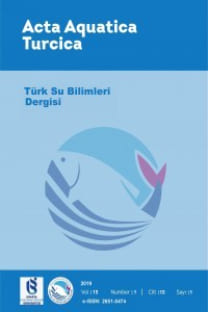Orta Ege Denizi’nde Yüzer Ağ Kafes Sistemlerinde Yerleşen Makro alg ve Makro omurgasız Türler Üzerine Bir Ön Araştırma
Ege Denizi, yüzer ağ kafes sistemi, makro omurgasız, makro alg, biofouling
A Preliminary Study on Macroalgae and Invertebrate Species Settling in Floating Net Cage Systems in the Central Aegean Sea
Aegean Sea, floating net cage, macroinvertebrates, macroalgae, biofouling,
___
- Beveridge, M. (1987). Cage Aquaculture. A division of Blackwell Scientific Publication. Fishing News Book, Oxford.
- Braithwaite, R., A., & McEvoy, L., A. (2005). Marine biofouling on fish farms and ıts remediation Advances in Marıne Biology, 47, 215-252.
- Bülbül, Z., & Filik, N. (2019). Gemi yapımında kullanılan ahşap malzemelerde oluşan biyofilm ve fouling. Mühendislik Bilimleri ve Tasarım Dergisi, 7(1), 1-6.
- Clarke, K. R. and Gorley, R. N., 2006, PRIMER v6: User Manual/Tutorial, PRIMER-E, Plymouth.
- Cook, E.J., Black, K.D., Sayer, M. D. J., Cromey, C.J., Angel, D.L., Spanier, E., A. Tsemel, Katz, T. Eden, N., Karakassis,I., Tsapakis, M., Apostolaki, E.T., & Malej, A. (2006). The influence of caged mariculture on the early development of sublittoral fouling communities: a pan-European study. ICES Journal of Marine Science, 63(4), 637-649.
- Dikel, S. (2002). Su Ürünlerinde Mekanizasyon. II. Baskı Çukurova Üniversitesi, Su Ürünleri Fakültesi Yayınları, Adana.
- FAO (2018). The State of World’s Fisheries and Aquaculture, Rome. 200p.
- Fischer, W., Schneider, M., & Bauchot, M.L. (1987). Fiches FAO d'identification des especes pour les besoins de la pêche. Méditerranée et Mer Noire (Zone De Pêche 37),Révision 1. Méditerranée et mer Noire, (2), 1529p.
- Gordon, C. (1998). Tarihte Neler Oldu (Çev: Mete Tunçay-Alaeddin Şenel), Kırmızı Yayınları, İstanbul.
- Hernandez, I., Fernandez-Engo, M.A., Perez-Llorens, J.L, & Vergara, J.J. (2005). Integrated outdoor culture of two estuarine macroalgae as biofilters for dissolved nutrients from Sparus auratus waste waters. Journal of Applied Phycology, (17), 557-567.
- Hodson, S. L., Burke, C. M. & Bissett, A. P. (2000). Biofouling of fish-cage netting: The efficacy of a silicone coating and the effect of netting colour. Aquaculture, 184 (3-4), 277–290.
- Hodson, S. L., Burke, C. M., & Lewis, T. E. (1995). In situ quantification of fishcage fouling by underwater photography and image analysis. Biofouling, 9(2), 145-151.
- Hodson, S. L., Lewis, T. E., & Burke, C. M. (1997). Biofouling of fish-cage netting: efficacy and problems of in situ cleaning. Aquaculture, 152 (1-4), 77–90.
- Hoşsucu, H. (1991). Balıkçılık (Av Araçları ve Avlanma Yöntemleri). VII. Baskı, Ege Üniversitesi, Su Ürünleri Yüksekokul Yayınları, İzmir.
- Houghton, D. R., (1978). Marine fouling and offshore structrures. Ocean Management, 4(2-4), 347-352.
- Jahani, N., Madiseh, S.D., Nabavi S.M.B.& Isapour, F. (2018). Determination of the effects of marine fish cage culture on benthic communities of Ghazale Creek (NW of Persian Gulf) using benthic indices. Research & Reviews: Journal of Ecology and Environmental Sciences, 6 (2), 1-7.
- Kassah, J., E. (2021). Development of biofouling on salmon cage nets and the effects of anti-fouling treatments on the survival of the hydroid (Ectopleura larynx) (Ellis & Solander, 1786). Master’sThesis. Norwegian University of Science and Technology Faculty of Natural Sciences and Technology. Trondheim, 65.
- Koçak, F., Ergen, Z., & Çınar, M. E. (1998). Bodrum limanında (Ege denizi) fouling gelişimi. Bodrum Yarımadası Çevre Sorunları Sempozyumu Bildıriler Kitabı. (1), 139-146.
- Mhaddolkar S. S., Loka, J., Philipose, K.K. & Dineshbabu, A.P. (2017). Experimental studies on macro fouling communities on net panels at marine cage farm of Karwar, India. International Journal of Fisheries and Aquatic Studies, 5(2), 184-187.
- Nellis, P., & Bourget, E. (1996). Influence of physical and chemical factors on settlement and recruitment of the hydroid Tubularia larynx. Marine Ecology Progress Series, (140), 123-139.
- Palomares, M.,L.,D., & D. Pauly. (2021) SeaLifeBase. World Wide Web electronic publication. www.sealifebase.org, version (08/2021).
- Poppe, G. & Goto, Y. (1993). European Seashells (2), ConchBooks Wiesbaden: Hemmen.
- Porter, C., B., Krom, M., D., Robbins, M., G., Brickell, L., & Davidson, A. (1987). Ammonia excretion and total N budget of gilthead seabream (Sparus aurata) and its effect on water quality conditions. Aquaculture, 66 (3), 287-97.
- Price, C., S., & Morris, J. A., Jr. (2013). Marine cage culture and the environment: Twenty-first century science informing a sustainable industry. NOAA Technical Memorandrum NOS NCCOS (164).
- Relini, G., (1990). Insediamento di organismi marini di substrato duro in ambienti portuali mediterranei. Memorie di Biologia Marina e di Oceanografia, (l0) 6l-70.
- Scott, D., C.,B. & Muir, J.,F. (2000). Offshore cage systems: A practical overview. In: J. Muir, & B. Basurco, Mediterranean offshore mariculture, Options Méditerranéennes (B), 79-89). Zaragoza.: Etudes et Recherches(CIHEAM).
- Shanmao, C., Congyao, Z., Guofan, Z., &Yujing, W. (1998). Study on species composition of fouling organisms on mariculture cages [J]. Journal of Dalian Fisheries University, 4.
- Svane, I., Cheshire, A. & Barnett, J. (2006) Test of an antifouling treatment on tuna fish cages in Boston Bay, Port Lincoln, South Australia. Bio-fouling, 22(4), 209-219.
- Tebble, N. (1966). British Bivalve Seashells. Trustees of The British Museum (Natural history), London. TÜİK (2019). Su Ürünleri İstatistikleri. TÜİK Yayını, Çankaya-Ankara.
- Weston, D.,G. (1990). Quantitative examination of macrobenthic community changes along an organic enrichment gradient. Marine Ecology Progress Series, 61(3), 233-244.
- WoRMS Editorial Board. (2021). World Register of Marine species. VLIZ: http://www.marinespecies.org
- Yayın Aralığı: 4
- Başlangıç: 1988
- Yayıncı: Yunus Ömer BOYACI
Gürkan DİKEN, Hayati KÖKNAROĞLU, İsmail CAN
Antalya'da Bir Deniz Akvaryumu Su Temini Sisteminin Çevresinde Gözlenen Bentik Makrofauna Örnekleri
Balık Yan Ürünlerinin ve Atıklarının Yeni Kullanımı: Protein Hidrolizatları
Ali ULAŞ, Serpil SERDAR, Şükrü YILDIRIM, Didem GÖKTÜRK
Antalya'da Bir Deniz Akvaryumu Su Temini Sisteminin Çevresinde Gözlenen Bentik Makrofauna Örnekleri
Osman Tolga ÖZEL, Selin ERTÜRK GÜRKAN
Ahmet BAYKÖSE, Halim Aytekin ERGÜL, Deniz Anıl ODABAŞI, Nurcan ÖZKAN, Serpil ODABAŞI, Yunus Ömer BOYACI
Esra BALIKÇI, Yeşim ÖZOĞUL, Mustafa DURMUŞ, Yılmaz UÇAR, Saadet GÖKDOĞAN TEKİN
Figen Esin KAYHAN, Harika Eylül ESMER DURUEL, Şeyma TARTAR KIZILKAYA, Güllü KAYMAK, Cansu AKBULUT, Hayriye GENÇ, Mustafa ZENGİN, Nazan Deniz YÖN ERTUĞ
